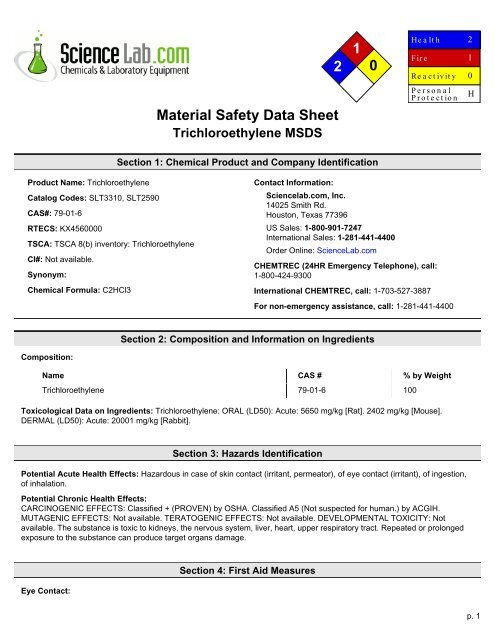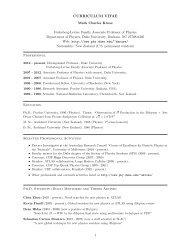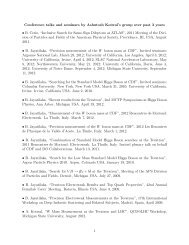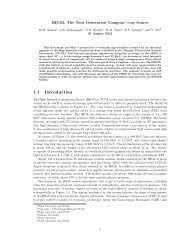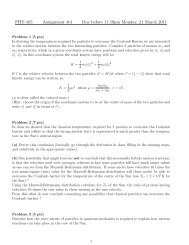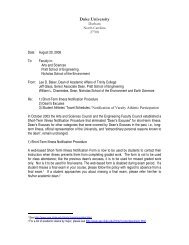Trichloroethylene - Duke Physics
Trichloroethylene - Duke Physics
Trichloroethylene - Duke Physics
Create successful ePaper yourself
Turn your PDF publications into a flip-book with our unique Google optimized e-Paper software.
Material Safety Data Sheet<br />
<strong>Trichloroethylene</strong> MSDS<br />
1<br />
2 0<br />
He a lt h<br />
Fir e<br />
Re a c t iv it y<br />
P e r s o n a l<br />
P r o t e c t io n<br />
2<br />
1<br />
0<br />
H<br />
Section 1: Chemical Product and Company Identification<br />
Product Name: <strong>Trichloroethylene</strong><br />
Catalog Codes: SLT3310, SLT2590<br />
CAS#: 79-01-6<br />
RTECS: KX4560000<br />
TSCA: TSCA 8(b) inventory: <strong>Trichloroethylene</strong><br />
CI#: Not available.<br />
Synonym:<br />
Chemical Formula: C2HCl3<br />
Contact Information:<br />
Sciencelab.com, Inc.<br />
14025 Smith Rd.<br />
Houston, Texas 77396<br />
US Sales: 1-800-901-7247<br />
International Sales: 1-281-441-4400<br />
Order Online: ScienceLab.com<br />
CHEMTREC (24HR Emergency Telephone), call:<br />
1-800-424-9300<br />
International CHEMTREC, call: 1-703-527-3887<br />
For non-emergency assistance, call: 1-281-441-4400<br />
Section 2: Composition and Information on Ingredients<br />
Composition:<br />
Name CAS # % by Weight<br />
<strong>Trichloroethylene</strong> 79-01-6 100<br />
Toxicological Data on Ingredients: <strong>Trichloroethylene</strong>: ORAL (LD50): Acute: 5650 mg/kg [Rat]. 2402 mg/kg [Mouse].<br />
DERMAL (LD50): Acute: 20001 mg/kg [Rabbit].<br />
Section 3: Hazards Identification<br />
Potential Acute Health Effects: Hazardous in case of skin contact (irritant, permeator), of eye contact (irritant), of ingestion,<br />
of inhalation.<br />
Potential Chronic Health Effects:<br />
CARCINOGENIC EFFECTS: Classified + (PROVEN) by OSHA. Classified A5 (Not suspected for human.) by ACGIH.<br />
MUTAGENIC EFFECTS: Not available. TERATOGENIC EFFECTS: Not available. DEVELOPMENTAL TOXICITY: Not<br />
available. The substance is toxic to kidneys, the nervous system, liver, heart, upper respiratory tract. Repeated or prolonged<br />
exposure to the substance can produce target organs damage.<br />
Eye Contact:<br />
Section 4: First Aid Measures<br />
p. 1
Check for and remove any contact lenses. Immediately flush eyes with running water for at least 15 minutes, keeping eyelids<br />
open. Cold water may be used. Do not use an eye ointment. Seek medical attention.<br />
Skin Contact:<br />
After contact with skin, wash immediately with plenty of water. Gently and thoroughly wash the contaminated skin with running<br />
water and non-abrasive soap. Be particularly careful to clean folds, crevices, creases and groin. Cover the irritated skin with an<br />
emollient. If irritation persists, seek medical attention. Wash contaminated clothing before reusing.<br />
Serious Skin Contact:<br />
Wash with a disinfectant soap and cover the contaminated skin with an anti-bacterial cream. Seek medical attention.<br />
Inhalation: Allow the victim to rest in a well ventilated area. Seek immediate medical attention.<br />
Serious Inhalation:<br />
Evacuate the victim to a safe area as soon as possible. Loosen tight clothing such as a collar, tie, belt or waistband. If<br />
breathing is difficult, administer oxygen. If the victim is not breathing, perform mouth-to-mouth resuscitation. Seek medical<br />
attention.<br />
Ingestion:<br />
Do not induce vomiting. Loosen tight clothing such as a collar, tie, belt or waistband. If the victim is not breathing, perform<br />
mouth-to-mouth resuscitation. Seek immediate medical attention.<br />
Serious Ingestion: Not available.<br />
Section 5: Fire and Explosion Data<br />
Flammability of the Product: May be combustible at high temperature.<br />
Auto-Ignition Temperature: 420°C (788°F)<br />
Flash Points: Not available.<br />
Flammable Limits: LOWER: 8% UPPER: 10.5%<br />
Products of Combustion: These products are carbon oxides (CO, CO2), halogenated compounds.<br />
Fire Hazards in Presence of Various Substances: Not available.<br />
Explosion Hazards in Presence of Various Substances:<br />
Risks of explosion of the product in presence of mechanical impact: Not available. Risks of explosion of the product in<br />
presence of static discharge: Not available.<br />
Fire Fighting Media and Instructions:<br />
SMALL FIRE: Use DRY chemical powder. LARGE FIRE: Use water spray, fog or foam. Do not use water jet.<br />
Special Remarks on Fire Hazards: Not available.<br />
Special Remarks on Explosion Hazards: Not available.<br />
Section 6: Accidental Release Measures<br />
Small Spill: Absorb with an inert material and put the spilled material in an appropriate waste disposal.<br />
Large Spill:<br />
Absorb with an inert material and put the spilled material in an appropriate waste disposal. Be careful that the product is not<br />
present at a concentration level above TLV. Check TLV on the MSDS and with local authorities.<br />
Section 7: Handling and Storage<br />
Precautions:<br />
Keep locked up Keep away from heat. Keep away from sources of ignition. Empty containers pose a fire risk, evaporate the<br />
residue under a fume hood. Ground all equipment containing material. Do not ingest. Do not breathe gas/fumes/ vapour/<br />
p. 2
spray. Wear suitable protective clothing In case of insufficient ventilation, wear suitable respiratory equipment If ingested, seek<br />
medical advice immediately and show the container or the label. Avoid contact with skin and eyes<br />
Storage:<br />
Keep container dry. Keep in a cool place. Ground all equipment containing material. Carcinogenic, teratogenic or mutagenic<br />
materials should be stored in a separate locked safety storage cabinet or room.<br />
Section 8: Exposure Controls/Personal Protection<br />
Engineering Controls:<br />
Provide exhaust ventilation or other engineering controls to keep the airborne concentrations of vapors below their respective<br />
threshold limit value. Ensure that eyewash stations and safety showers are proximal to the work-station location.<br />
Personal Protection:<br />
Splash goggles. Lab coat. Vapor respirator. Be sure to use an approved/certified respirator or equivalent. Gloves.<br />
Personal Protection in Case of a Large Spill:<br />
Splash goggles. Full suit. Vapor respirator. Boots. Gloves. A self contained breathing apparatus should be used to avoid<br />
inhalation of the product. Suggested protective clothing might not be sufficient; consult a specialist BEFORE handling this<br />
product.<br />
Exposure Limits:<br />
TWA: 50 STEL: 200 (ppm) from ACGIH (TLV) TWA: 269 STEL: 1070 (mg/m3) from ACGIH Consult local authorities for<br />
acceptable exposure limits.<br />
Physical state and appearance: Liquid.<br />
Odor: Not available.<br />
Taste: Not available.<br />
Molecular Weight: 131.39 g/mole<br />
Color: Clear Colorless.<br />
pH (1% soln/water): Not available.<br />
Boiling Point: 86.7°C (188.1°F)<br />
Melting Point: -87.1°C (-124.8°F)<br />
Critical Temperature: Not available.<br />
Specific Gravity: 1.4649 (Water = 1)<br />
Vapor Pressure: 58 mm of Hg (@ 20°C)<br />
Vapor Density: 4.53 (Air = 1)<br />
Volatility: Not available.<br />
Odor Threshold: 20 ppm<br />
Section 9: Physical and Chemical Properties<br />
Water/Oil Dist. Coeff.: The product is equally soluble in oil and water; log(oil/water) = 0<br />
Ionicity (in Water): Not available.<br />
Dispersion Properties: See solubility in water, methanol, diethyl ether, acetone.<br />
Solubility:<br />
Easily soluble in methanol, diethyl ether, acetone. Very slightly soluble in cold water.<br />
Section 10: Stability and Reactivity Data<br />
p. 3
Stability: The product is stable.<br />
Instability Temperature: Not available.<br />
Conditions of Instability: Not available.<br />
Incompatibility with various substances: Not available.<br />
Corrosivity:<br />
Extremely corrosive in presence of aluminum. Non-corrosive in presence of glass.<br />
Special Remarks on Reactivity: Not available.<br />
Special Remarks on Corrosivity: Not available.<br />
Polymerization: No.<br />
Section 11: Toxicological Information<br />
Routes of Entry: Dermal contact. Eye contact. Inhalation. Ingestion.<br />
Toxicity to Animals:<br />
Acute oral toxicity (LD50): 2402 mg/kg [Mouse]. Acute dermal toxicity (LD50): 20001 mg/kg [Rabbit].<br />
Chronic Effects on Humans:<br />
CARCINOGENIC EFFECTS: Classified + (PROVEN) by OSHA. Classified A5 (Not suspected for human.) by ACGIH. The<br />
substance is toxic to kidneys, the nervous system, liver, heart, upper respiratory tract.<br />
Other Toxic Effects on Humans: Hazardous in case of skin contact (irritant, permeator), of ingestion, of inhalation.<br />
Special Remarks on Toxicity to Animals: Not available.<br />
Special Remarks on Chronic Effects on Humans: Passes through the placental barrier in human. Detected in maternal milk<br />
in human.<br />
Special Remarks on other Toxic Effects on Humans: Not available.<br />
Ecotoxicity: Not available.<br />
BOD5 and COD: Not available.<br />
Section 12: Ecological Information<br />
Products of Biodegradation:<br />
Possibly hazardous short term degradation products are not likely. However, long term degradation products may arise.<br />
Toxicity of the Products of Biodegradation: The products of degradation are more toxic.<br />
Special Remarks on the Products of Biodegradation: Not available.<br />
Waste Disposal:<br />
Section 13: Disposal Considerations<br />
DOT Classification: CLASS 6.1: Poisonous material.<br />
Identification: : <strong>Trichloroethylene</strong> : UN1710 PG: III<br />
Section 14: Transport Information<br />
p. 4
Special Provisions for Transport: Not available.<br />
Section 15: Other Regulatory Information<br />
Federal and State Regulations:<br />
California prop. 65: This product contains the following ingredients for which the State of California has found to cause<br />
cancer, birth defects or other reproductive harm, which would require a warning under the statute: <strong>Trichloroethylene</strong> California<br />
prop. 65: This product contains the following ingredients for which the State of California has found to cause cancer which<br />
would require a warning under the statute: <strong>Trichloroethylene</strong> Pennsylvania RTK: <strong>Trichloroethylene</strong> Florida: <strong>Trichloroethylene</strong><br />
Minnesota: <strong>Trichloroethylene</strong> Massachusetts RTK: <strong>Trichloroethylene</strong> New Jersey: <strong>Trichloroethylene</strong> TSCA 8(b) inventory:<br />
<strong>Trichloroethylene</strong> CERCLA: Hazardous substances.: <strong>Trichloroethylene</strong><br />
Other Regulations: OSHA: Hazardous by definition of Hazard Communication Standard (29 CFR 1910.1200).<br />
Other Classifications:<br />
WHMIS (Canada):<br />
CLASS D-1B: Material causing immediate and serious toxic effects (TOXIC). CLASS D-2B: Material causing other toxic effects<br />
(TOXIC).<br />
DSCL (EEC):<br />
R36/38- Irritating to eyes and skin. R45- May cause cancer.<br />
HMIS (U.S.A.):<br />
Health Hazard: 2<br />
Fire Hazard: 1<br />
Reactivity: 0<br />
Personal Protection: h<br />
National Fire Protection Association (U.S.A.):<br />
Health: 2<br />
Flammability: 1<br />
Reactivity: 0<br />
Specific hazard:<br />
Protective Equipment:<br />
Gloves. Lab coat. Vapor respirator. Be sure to use an approved/certified respirator or equivalent. Wear appropriate respirator<br />
when ventilation is inadequate. Splash goggles.<br />
References: Not available.<br />
Other Special Considerations: Not available.<br />
Created: 10/10/2005 08:54 PM<br />
Last Updated: 11/01/2010 12:00 PM<br />
Section 16: Other Information<br />
The information above is believed to be accurate and represents the best information currently available to us. However, we<br />
make no warranty of merchantability or any other warranty, express or implied, with respect to such information, and we assume<br />
no liability resulting from its use. Users should make their own investigations to determine the suitability of the information for<br />
their particular purposes. In no event shall ScienceLab.com be liable for any claims, losses, or damages of any third party or for<br />
lost profits or any special, indirect, incidental, consequential or exemplary damages, howsoever arising, even if ScienceLab.com<br />
has been advised of the possibility of such damages.<br />
p. 5


